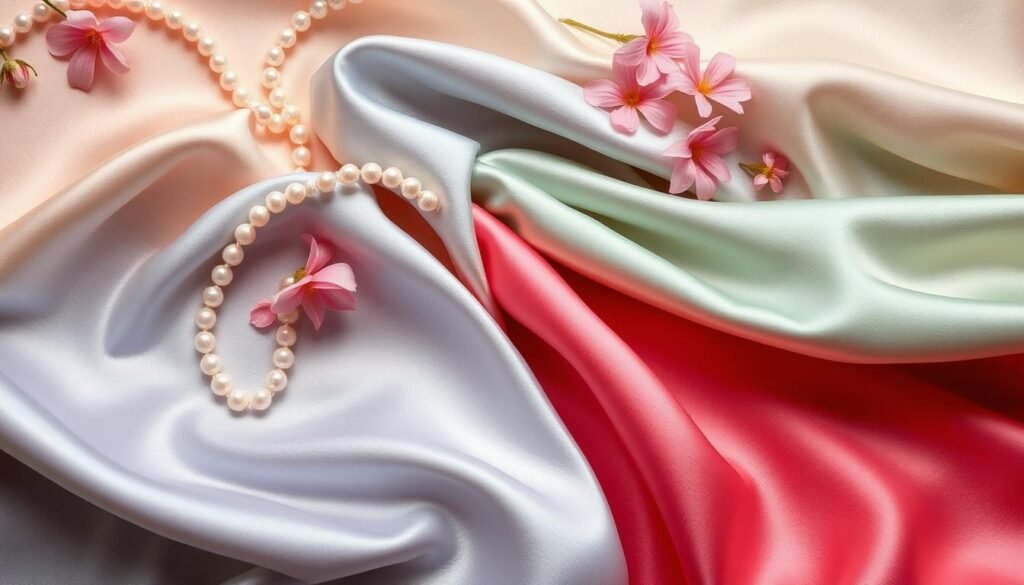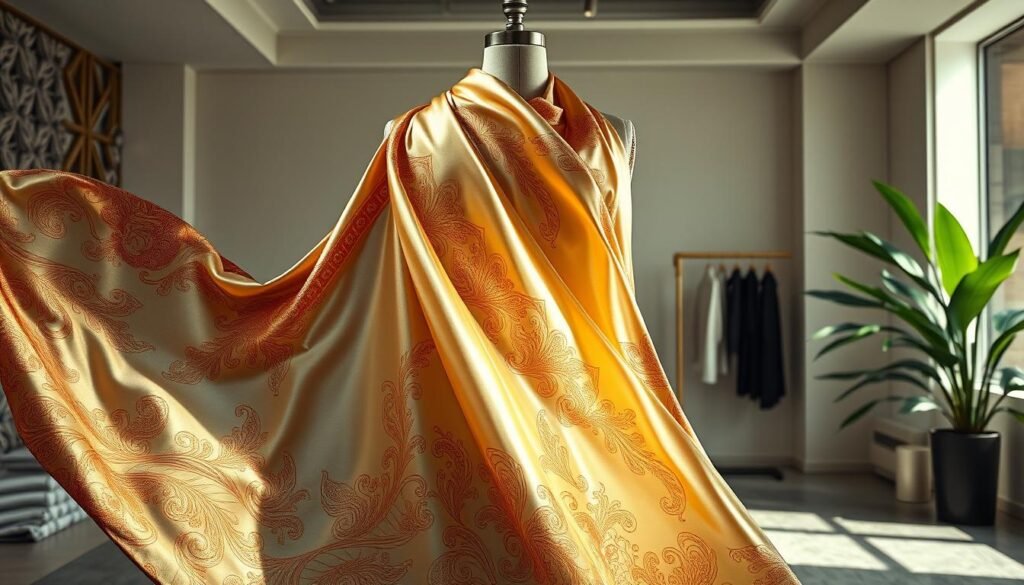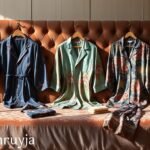Silk is a natural fiber known for its elegance and strength. It comes from ancient China, where making it was a secret1. Now, silk is a top choice for its smooth feel, breathability, and ability to keep you cool or warm1. We’ll look into silk’s special features, the different types, and its uses in fashion, home decor, and more.
Key Takeaways
- Silk is a luxurious natural fiber known for its exceptional smoothness and sheen.
- Silk fabrics offer a range of properties, including strength, breathability, and thermal regulation.
- Silk production has a rich history dating back to ancient China and has been a closely guarded secret.
- Silk is used in a wide variety of applications, from high-end clothing to home decor and even office supplies.
- While silk is a delicate fabric, it is also highly durable and known for its hypoallergenic nature.
Introduction to Silk Fabric
Silk is called the “king of fabrics”2 because it’s so soft and shiny. It feels great on the skin. Silkworms make long fibers that create a smooth fabric2.
Silk has been a favorite for a long time. In ancient China, making silk was a secret2.
The Luxurious Feel of Silk
Silk feels luxurious because of its natural qualities2. Mulberry silk is the best quality silk. It’s smooth and shiny2.
Tussah silk comes from wild silkworms. It has unique colors and a special feel2.
Silk: The King of Fabrics
People started making silk in other places too. It became a symbol of luxury2. Charmeuse silk is shiny on one side and matte on the other. It’s great for dresses and blouses2.
Silk is strong, stretchy, and lets air in. It’s perfect for making fancy and comfy items2. It’s also good for the planet and people with sensitive skin2.
Silk comes in many colors, from natural to bright2. Taking care of silk is important. You should wash it by hand and dry it in the air2.
Mulberry silk is from Bombyx mori silkworms. It’s very fine and shiny3. Tussah silk is from wild silkworms and has a unique look3.
Chiffon is light and perfect for fancy events3. Dupioni has a special texture and is great for formal wear3. Satin is smooth and often used in lingerie and evening dresses3.
Grade 6A silk is the best quality silk. It’s soft, strong, and keeps colors bright4. Grade 5A silk is also very good. It’s soft, strong, and keeps colors bright4. Grade 4A silk is soft and popular for luxury items4.
Silk is loved for its many uses. Discover the luxury of custom silk. It’s comfortable and elegant234.
Properties of Silk Fabric
Silk is known for its special qualities that make it stand out. It looks delicate but is really strong and lasts a long time5. The silk threads are long and strong, making the fabric tough and long-lasting5.
Strength and Durability
Silk is very strong, as strong as steel5. It comes from the cocoon of silkworms and has long threads. These threads make silk strong and long-lasting5.
Breathability and Thermal Regulation
Silk lets air in well, keeping you cool or warm as needed5. It’s good at letting air through, so you stay comfortable in any weather5. Silk also keeps its shape well and fits comfortably5.
Absorbency and Drying Speed
Silk absorbs moisture quickly, making it useful for clothes and textiles5. It dries fast, which is great for laundry5.
| Silk Fabric Properties | Description |
|---|---|
| Strength and Durability | One of the strongest natural fibers, with a tensile strength comparable to steel. The continuous silk filaments contribute to the fabric’s resistance to tearing. |
| Breathability and Thermal Regulation | Highly breathable, allowing for efficient air circulation and temperature control. The elasticity of silk fabric helps retain its shape and provide comfort. |
| Absorbency and Drying Speed | A natural absorbent that quickly wicks away moisture, while also drying faster than many other textiles. |
“Silk is a natural fiber known for its luxurious feel, exceptional strength, and superior thermal regulation properties. These unique characteristics make it a highly sought-after material in the fashion and textile industries.”
Silk has amazing fabric properties, like strength, breathability, and more56. These make silk a top choice for many uses, from clothes to home decor.
Types of Silk Fabric
The silk fabric market has many options, each with unique features and uses. From the light, flowing chiffon and crinkle chiffon to the structured organza and georgette, silk fabrics are fascinating7.
Chiffon and Crinkle Chiffon
Chiffon and crinkle chiffon are known for their light, airy feel. They are often used in flowing, feminine designs. These fabrics are perfect for formal wear, bridal gowns, and elegant evening outfits7.
Organza and Georgette
Organza and georgette are structured yet still see-through silks. Georgette has a unique pebbly texture that adds beauty to the fabric. These silks are versatile, used in clothes and home textiles, like dresses, blouses, curtains, and table runners7.
Crêpe de Chine and Habotai
Crêpe de Chine is a dense, matte-sheen silk good for many uses. It’s smooth and has a subtle sheen, making it great for clothes and home decor. Habotai is very light and often used as a lining, adding luxury to clothes and accessories7.
“Silk is the queen of all fabrics, the fabric of the gods.”
– Napoleon Bonaparte
Charmeuse and Satin Crêpe
Silk charmeuse and satin crêpe are top choices for luxury fabrics. Charmeuse shines with a liquid-like sheen and feels super soft. It’s perfect for fancy night clothes and fancy lingerie8. Satin crêpe mixes satin’s shine with crêpe’s flow, making it great for many uses.
Charmeuse silk ranges from 12-28 momme (MM) in weight, loved by luxury designers8. Satin crêpe looks like charmeuse and feels just as soft8. Both fabrics are comfy, strong, and add class to any item or home textile.

These silk fabrics show the skill of silk makers, especially in China, the biggest silk producer8. They have a beautiful drape, shine, and let air flow well. Charmeuse and satin crêpe are known for their silk luxury9.
| Silk Fabric | Average Weight Range (Momme) |
|---|---|
| Silk Chiffon | 5-12 MM |
| Crinkle Chiffon | 5-12 MM |
| Organza | 5-12 MM |
| Crêpe de Chine | 12-16 MM (standard), 30-40 MM (heavyweight) |
| Silk Charmeuse | 12-28 MM |
| Satin Crêpe | 12-28 MM |
“Charmeuse silk is the most popular weave of silk for pillowcases, sheets, and bedding.”9
Charmeuse and satin crêpe are key in luxury fashion, home décor, and more. Their beauty and lasting charm win over designers, makers, and those who love fine things.
Dupioni, Shantung, and Tussah Silk
There are many unique silk fabrics beyond the well-known ones. Silk dupioni is a dense, shiny silk with a subtle shine. It’s perfect for formal outfits10. Silk shantung has a crisp look and feels a bit rough. Tussah silk, from wild silkworms, looks coarser and matte10.
Tussah silk is also called Tussar or Tasar silk. It’s a wild silk that looks dark golden11. It comes from the Antheraea pernyi silkworm found in Assam, India11. Tussah silk feels coarse and looks more muted than mulberry silk10.
Silk dupioni gets its special look from a unique weaving method. This makes it shiny and colorful12. It’s strong, doesn’t wrinkle much, and is great for formal clothes and structured items10.
Silk shantung feels crisp and looks textured with a bit of roughness. It gives a casual, rustic look10. This fabric is used in many things, from clothes to home decor.
These silk types each have their own special look and feel. They add to the luxury and variety of silk101211.
Silk Blends and Fabric Combinations
Silk is a versatile fiber that blends well with many other natural fibers. These blends mix the luxurious feel of silk with the unique traits of other fibers13.
Silk-Wool Blends
Silk-wool blends are great for cold weather. They combine wool’s warmth with silk’s softness13. You’ll find these in sweaters and coats, adding both comfort and style.
Silk-Cotton Blends
Silk-cotton blends mix silk’s breathability with cotton’s durability13. This makes a fabric that’s comfy and practical. It’s perfect for everything from casual shirts to formal dresses.
These silk blends look good and perform well. They’re a top pick for designers and those who know quality13. Mixing silk with other fibers creates a fabric that’s better in every way.
“Silk blends seamlessly with other natural fibers, unlocking a world of versatility and luxury in textile design.”
The History and Origins of Silk
The story of silk starts in ancient China, thanks to Empress Leizu around 2700 BC14. The Chinese kept silk production a secret for many years, seeing it as a valuable trade item15. Over time, silk spread to other areas, making it a symbol of luxury and exclusivity.
In the Middle Ages, silk was used for royal robes and tunics15. By the Renaissance, the wealthy loved silk for making fancy gowns and doublets15. Now, silk is more available for fashion and tailoring thanks to new production methods15.
Now, silk making isn’t just in one place14. China leads in silk production14, while India is famous for its silk types14. Japan is known for its Habutai silk14, and Brazil for its colorful silk14. Uzbekistan is known for its detailed silk patterns14, and Italy for luxury fabrics like brocade and velvet14. France is famous for its silk scarves and high fashion14.
The story of silk shows its lasting beauty and flexibility15. From ancient China to today, silk remains a symbol of luxury and style, inspiring fashion and cultural exchange worldwide.
| Country | Silk Production |
|---|---|
| China | Largest producer of silk in the world14 |
| India | Well-known for its diverse range of silk varieties14 |
| Japan | Renowned for producing delicate fabrics like Habutai silk14 |
| Brazil | Recognized for its vibrant colored silk fabrics14 |
| Uzbekistan | Has a long history of silk production and is known for its intricate patterns14 |
| Italy | Associated with luxurious silk fabrics such as brocade and velvet14 |
| France | Famous for its silk scarves and haute couture14 |
“Silk is the queen of textiles, and textiles are the fabric of dreams.” – Unknown
Silk in Fashion and Apparel
Silk is a top choice for fashion and apparel because of its elegance and luxurious feel. Designers love silk for its smooth flow and shiny look. They use it in many types of clothes, from formal wear to lingerie16.
Silk in Formal and Bridal Wear
Silk is perfect for formal and bridal clothes. Mulberry silk is strong and fine, making it great for dresses16. Tussar silk is also popular for weddings, offering a unique look16.
Silk in Lingerie and Nightwear
Silk is great for lingerie and nightwear because it breathes and keeps moisture away1617. It’s smooth, so it doesn’t cause skin irritation or show lines and wrinkles17. Habotai silk is often used for fancy sleepwear and undergarments16.
Silk is a top fabric in fashion and apparel. It’s loved for its beauty and how well it performs. From fancy dresses to intimate clothes, silk is a favorite among designers and buyers.

Silk in Home Decor and Textiles
The versatility of silk goes beyond fashion. It’s also big in home decor and textiles. Silk sheets, pillowcases, and duvet covers make sleeping feel luxurious. Silk curtains and upholstery add elegance to any room18. Its natural shine and how it drapes make it great for throws, pillows, and rugs too.
Mulberry silk is a top pick for home textiles18. It’s smooth and fine, thanks to its special fibers18. Making mulberry silk involves careful silkworm care and feeding them mulberry leaves18. Sometimes, one mulberry silk cocoon can produce up to 900 meters of silk18.
Tussar silk is another type used in home decor. It has a unique texture that’s a bit rough and organic-looking18. Tussar silk comes in many colors, like beige, golden, brown, grey, and green18.
Habotai silk is soft and flows beautifully18. Dupioni silk has a special texture with slubs for added depth18. Charmeuse silk has a shiny side and a matte side, making it perfect for bedding and decor19.
| Silk Fabric Type | Characteristics | Home Decor Applications |
|---|---|---|
| Mulberry Silk | Fine and uniform fibers, incredibly smooth and silky feel18 | Sheets, pillowcases, duvet covers |
| Tussar Silk | Coarse and uneven texture, rustic and organic look18, wide range of natural colors18 | Curtains, upholstery, throws |
| Habotai Silk | Soft and fluid drape18 | Bedding, decorative accents |
| Dupioni Silk | Distinctive texture with irregular slubs, rough feel similar to raw silk18 | Curtains, pillows, rugs |
| Charmeuse Silk | Satin-like finish on one side, matte finish on the other19 | Bedding, decorative accents |
“Silk’s natural luster and draping properties make it a popular choice for decorative accessories, such as throws, pillows, and even rugs.”
Silk’s use in home decor and textiles shows its lasting beauty and elegance. It can make any room feel luxurious, from bedding to curtains and upholstery.
Caring for Silk Fabrics
Silk is a luxurious fabric that needs careful handling to keep its beauty. It’s important to know how to wash, clean, and store it right. This keeps silk looking great and lasting longer20.
Washing and Cleaning Silk
When washing silk, be gentle. Use Woolite® Delicates laundry detergent, made for delicate fabrics20. Always wash it in cold water to avoid damage20. You can handwash it or use a delicate cycle on your machine20.
Always check the care label for specific advice. Some silks need special care20. Never use chlorine bleach, as it can harm the silk20.
Storing and Preserving Silk
Storing silk right is key to keeping it in top shape. Keep it away from sunlight and moisture to prevent damage20. Let it air dry, as dryers can ruin silk20. Be gentle when handling it to avoid snags20.
By following these steps, silk lovers can keep their items looking beautiful for a long time.
| Silk Fabric Type | Characteristics |
|---|---|
| Mulberry Silk | The most common and widely used type of silk, resulting in smooth and fine threads21. |
| Tussar Silk | Also known as wild silk, has a unique texture and a slightly rougher feel compared to mulberry silk21. |
| Charmeuse Silk | A lightweight fabric with a glossy front and a matte back, often used in luxurious evening gowns and lingerie21. |
| Dupioni Silk | Characterized by its slubbed texture, favored for its unique aesthetic in formal wear and high-end home furnishings21. |
Silk is loved for its many benefits, like being hypoallergenic and keeping moisture away21. It also helps regulate temperature and smooths out fine lines and wrinkles21. With the right care, silk adds elegance and style to any space21.
“Silk is the queen of all textiles, and the textile of queens.”
What Is Silk Fabric? Understanding Its Luxury and Versatility
Silk is a special natural fiber that has been loved for centuries. It is known for its softness, strength, and many uses22. This fabric is called the “king of fabrics” because of its unique qualities. It comes from the silkworm, Bombyx mori, and is sought after for fashion, home decor, and more23.
Silk is known for its top-notch quality and how well it performs. Mulberry silk is the most common type and is prized for its strength, ability to keep moisture away, and keeping a steady temperature2223. Making silk involves silkworms eating mulberry leaves and spinning cocoons. This process creates a natural and sustainable fiber that is loved for its luxurious feel and durability23.
Silk is not just for clothes. It’s also used in accessories like scarves and pocket squares, which are always in style22. Silk curtains and drapes add luxury to any room, attracting high-end customers22. Silk bedding offers comfort and luxury for a good night’s sleep, appealing to those who value quality22.
Silk stands out in many forms, from elegant dresses to breathable sleepwear to luxurious home textiles. It’s great for people with sensitive skin or allergies because it’s hypoallergenic22. Silk also keeps you dry by absorbing sweat, making it perfect for all day or night use22.
To keep silk looking beautiful and lasting long, it needs special care22. Sometimes, delicate silk items need dry cleaning22. Knowing about silk’s amazing features and uses helps us see its timeless beauty and luxury.
“Silk is the queen of all textiles, the fabric of the gods, the ultimate in luxury and purity.”
– Diane von Furstenberg
Conclusion
Silk fabric is a true marvel. It combines luxury, strength, and versatility. It has a lustrous sheen and smooth feel. Silk is also very breathable24.
This guide has shown us the vast world of silk fabric. It has many types and uses. Each one shows the timeless beauty and lasting charm of this natural fiber.
24 Silk fabric is known for its elegance and luxury in fashion24. It’s also popular in interior design24. There are many types like chiffon, charmeuse, and satin crêpe25.
The structure and strength of silk fibers25 make it versatile. It’s also breathable and good at keeping moisture away24.
As we end our look at silk fabric, it’s clear it still inspires and captivates. It has a timeless beauty, great performance, and a long history. Silk fabric is a true symbol of luxury and skill, loved by many for years to come.
FAQ
What are the unique properties of silk fabric?
Silk is known for being very soft and shiny. It feels luxurious. It’s also one of the strongest natural fibers, as strong as steel.
It lets air through well, keeping you cool or warm as needed. Silk also dries fast and absorbs moisture well.
What are the different types of silk fabrics?
There are many types of silk fabrics. You can find chiffon, crinkle chiffon, and organza. Georgette, crêpe de Chine, and habotai are also popular.
Charameuse, satin crêpe, dupioni, shantung, and tussah silk are others. Each type has its own special uses.
How is silk fabric used in fashion and home decor?
Silk is great for formal clothes, wedding dresses, lingerie, and sleepwear. It looks beautiful and moves smoothly.
At home, silk is perfect for bedding and curtains. It’s also used for upholstery and decorative items like throws and pillows.
How should silk fabrics be cared for?
Wash silk gently, either by hand or with a soft detergent. Always air-dry it to keep it safe.
When storing silk, keep it away from sunlight and moisture. This helps keep it looking luxurious.
What is the history and origin of silk production?
Silk started in ancient China, thanks to Empress Leizu around 2700 BC. The Chinese kept its production secret for many years.
This made silk a valuable trade item. It was highly sought after.




